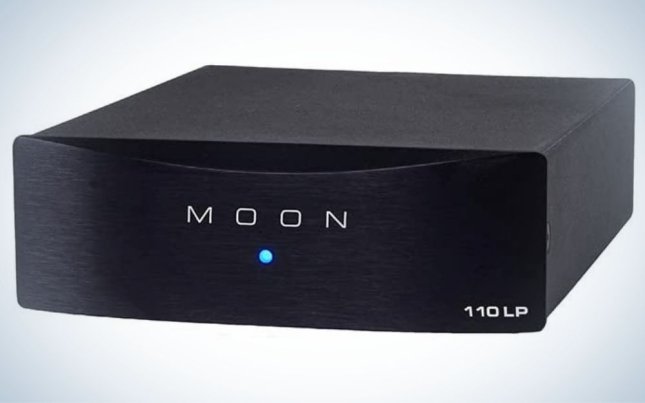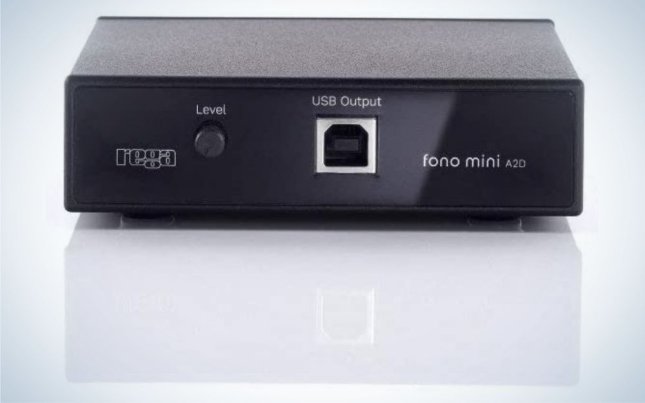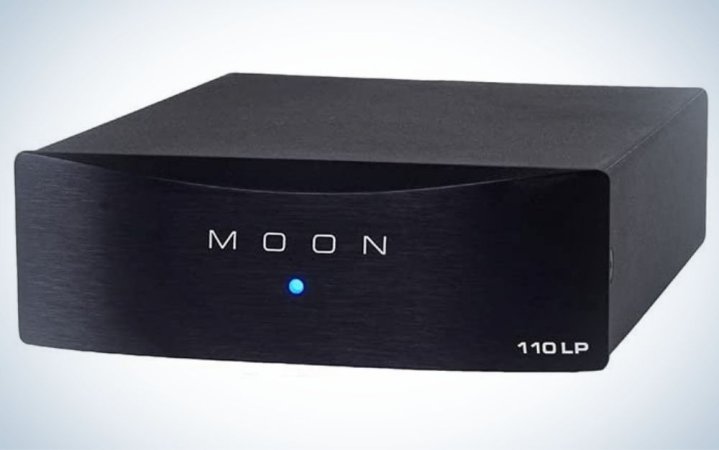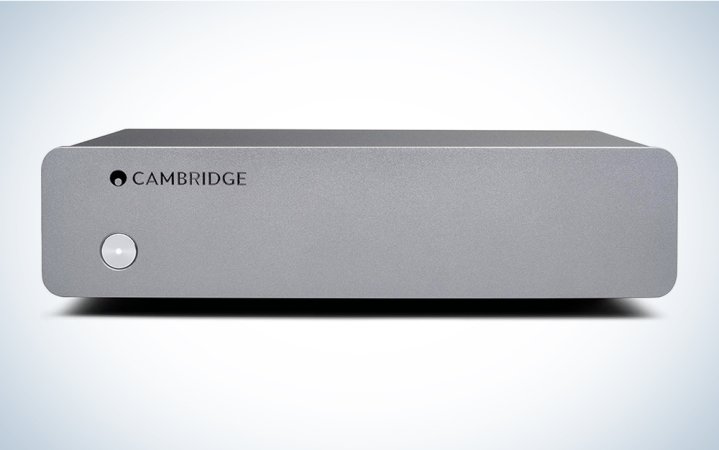We may earn revenue from the products available on this page and participate in affiliate programs. Learn more ›
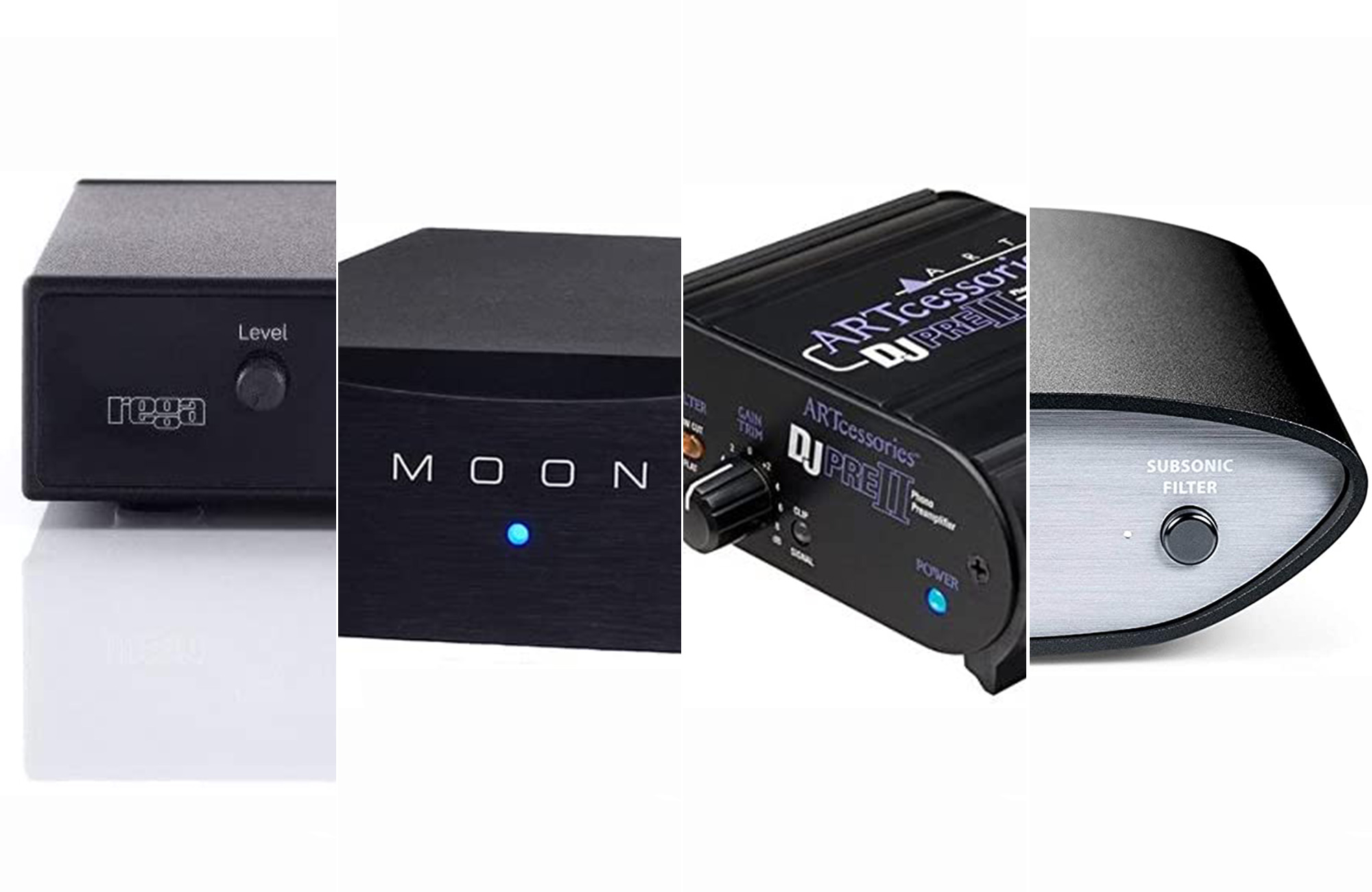
For many music connoisseurs, vinyl is the rule, not the exception, in their collections, and in most serious hi-fi systems, there’s a phono preamp between a turntable and mixer. That’s because most turntables, unlike CD players, deliver an audio signal without inherently raising it to the correct level for your receiver and speakers. Phono preamps solve this problem by boosting your turntable’s signal by between 40 dB to 50 dB. Additionally, phono preamps apply the standardized RIAA equalization curve, an industry standard that counteracts the innate highpass physically cut into most vinyl records produced after 1954. In short, phono preamps are the bridge between your turntable and A/V receiver and a crucial step in most audiophiles’ systems. They deliver excellent EQs that uncover the nuance and depth of your record without overtly coloring it, powerful gain that boosts it without bloating it, and offer control over output. Some even provide USB outs and customizable equalizers. Here are our picks for the best phono preamps worth a spin.
- Best overall: Moon by Simaudio
- Best entry-level: iFi Audio Zen Air Phono Preamp
- Best features: Rega – Fono Mini A2D
- Best high-end splurge: McIntosh MP100
- Best budget: ART DJPREII Phono Preamplifier
- Also worth considering: Cambridge Audio Alva Solo
How we chose the best phono preamps
As a lifelong musician and audio enthusiast, I own and have owned a revolving panoply of audio equipment. For this article, I researched phono preamps at all price points, surveying specs, user impressions, peer recommendations, and critical evaluations. I examined numerous models of preamps from many manufacturers, using my own knowledge of audio gear and my experience as a tech reviewer to compare and contrast these devices, sifting them into multiple categories and ranking them based on a few criteria. Firstly, I looked for phono preamps that do a great job at their crucial function of applying a reliable gain boost and solid RIAA curve. I prioritized phono preamps that deliver especially well, whether providing great moving magnet and moving coil capability in just one package, offering especially deep and robust sound stages, or including special premium features like analog-to-digital 24-bit USB out.
The best phono preamps: Reviews & Recommendations
Phono preamps usually don’t come with a lot of options and features, but that doesn’t mean they’re one size fits all. Rather, with these technical devices, it’s often important to be sure you know what your sound system needs before you invest. Here are our picks for the best phono preamps for all scenarios.
Best overall: Moon by Simaudio
Best overall
Elegant and Flexible
Pros
- Gain, impedance, and resistance controls make this device compatible with most MM or MC cartridges
- Gorgeous clear audio
- Great aesthetics
Cons
- No special features
- Pricey
Why it made the cut: This phono preamp from Simaudio offers a customizable and innately musical soundstage that pairs well with MM and most MC cartridge turntables.
Specs
- MM or MC: Both
- Gain control and filters: Yes
- Weight: 1.05
- Size: 9.2 x 7.1 x 2.2 inches
If you’re an audiophile looking for a gateway piece of kit to usher your vinyl system into true hi-fi audio, look no further than Moon by Simaudio. A celebrated manufacturer of collector audio equipment, Simaudio creates sonic stages that deliver crisp clarity, resonant depth, and bass response with enough drive that you can really hear the mallets in that first timpani roll in Finlandia (or Bernard Edwards “chuck” in “Everybody Dance”).
The Moon phono preamp delivers dialable gain, impedance, and resistance settings in the form of switches on the bottom plate, ensuring that your Moon can adapt to your turntable even after you’ve changed out the turntable’s cartridges. For a phono preamp at its price point, it offers decent MC cartridge capabilities that far exceed most of the competition; however, it still sounds thinner and less punchy with an MC cartridge than it will with an MM. That said, this is still one of the best MC-capable preamps with a price tag that doesn’t encroach on the $1,000 price point.
The Moon is a Canadian-made phono preamp that delivers an excellent, detailed sound and features enough versatility to pair well with nearly the whole spectrum of cartridges, even if its delivery falls off somewhat with the quietest end of the MC spectrum.
Best entry-level: iFi Audio Zen Air Phono Preamp
Best entry-level
Audiophile’s Gateway
Pros
- Excellent sound quality with great depth
- Subsonic smart roll-off filter
- Adjustable gain with MC capabilities
Cons
- Not as loud and bassy as some competitors
- May not give perfect performance with MC cartridges
Why it made the cut: With a wider-than-normal feature set for an entry-level phono preamp, the Zen delivers MM and MC capabilities with selectable gain and a smart subsonic filter, all while sounding remarkably nice.
Specs
- MM or MC: Both
- Gain control and filters: Yes
- Weight: 1.79 pounds
- Size: 10.87 x 6.14 x 2.32 inches
The iFi Audio Zen Air Phono Preamp is a rare audio gear piece that seems too good for its price point. It’s an entry-level preamp that costs a little more than some competitors yet boasts a feature set that exceeds what most of that competition delivers.
Based in Southport, United Kingdom, iFi has been developing high-end audio gear since 2012 (if you’re more into digital-first listening, the iFi xDSD Gryphon is one of our favorite DAC-amps). The company is known for its excellent sound and sleek, curvy enclosures, and the Zen Air phono preamp greatly matches its reputation. The Zen Air offers a sound stage without too much emphasis on the bass register, which supports a sound stage with nuance. Compared to the Pro-Ject Audio – Phono Box DC, which is typically $30 more, the Zen Air delivers more robust mids.
If its innate musicality isn’t enough to make this preamp worth it, the Zen Air’s feature set seals the deal. Perhaps most striking is the subsonic filter switch, which purportedly uses AI to dictate bass roll-off and, in practice, eliminates low flutter and drive rumble without cutting out the juicy low end of your track. The Zen handles MC capabilities with switchable gain levels on the rear. It delivers a lower-than-average noise floor, though, in practice, this will be greatly affected by your placement of the device around other electronics (as with any preamp).
All in all, the iFi Audio Zen is a remarkably capable entry-level preamp that impresses with its innate sound, feature set, and signature look. However, if you’re looking for a more traditionally square, nondescript component specifically for MM cartridges, the Fluance PA10 High Fidelity Phono Preamp is another $99 option with a selectable high pass filter.
Best features: Rega-Fono Mini A2D
Best features
Hi-Fi Goes Digital
Pros
- USB out
- Gain knob
Cons
- No MC capabilities
Why it made the cut: With great sound, and a built-in USB connection, this phono preamp makes sure your analog audio is ready for the digital age.
Specs
- MM or MC: MM only
- Gain control and filters: Yes
- Weight: .22 pounds
- Size: 10 x 7 x 2.5 inches
For most phono preamps, it’s enough to sound good and offer some breadth of connectivity—maybe they add an EQ into the mix—not so with the Rega-Fono Mini A2D, which doubles as an analog-to-digital converter with the help of its USB connection. The Fono Mini is particularly tiny by preamp standards, it weighs just .22 pounds. The housing features a simple gain knob on the front, next to a centrally located USB output. The back houses the customary ins and outs.
The Rega’s equalization tends toward bright highs but still produces decent bass. Its gain, which is adjusted with the knob on the front, delivers powerful boosting. The lack of EQ customization isn’t too much of a downside, as many receivers offer some degree of customizable EQ if you should want it, and the Rega inherently sounds nice.
It’s the Rega’s USB connection that makes this device really shine. It’s a feature that isn’t common in phono preamps unless you’re shopping for devices five times the price of the Rega, and it seriously expands what the phono preamp can do—and even be. The Rega-Fono Mini A2D is a preamp that questions the bounds of what a phono preamp can be.
Best high-end: McIntosh MP100
Best quality
True MM / MC Tyrannosaurus
Pros
- Gorgeous sound
- Excellent 24-bit USB digitizer included
- Coaxial and optical output
Cons
- Expensive
Why it made the cut: With immaculate sound, discrete MM and MC load dials, and a mechanical switch-off digitizer, the MP100 is a stacked preamp.
Specs
- MM or MC: MM and MC with discrete circuits
- Gain control and filters: Yes
- Weight: 8.6 pounds
- Size: 11.5 x 3.3 x 13.75 inches
Based in Binghamton, New York, McIntosh is famous for handcrafted, precisely engineered audio equipment. The McIntosh MP100 phono preamp is a true high-end phono preamp with one of the best feature sets on the market. With a glass front featuring the iconic McIntosh logo illuminated in green LEDs and a stainless steel housing, the MP100 shows off its quality at first glance. Those same extra long-lasting LEDs are used for a clipping indicator, as well as type above the various knobs and buttons along the front display. Front controls include separate tiered MM and MC load knobs, an MC/MM input button, a mono button, a digital output level button, and a standby button.
Perhaps the most exciting feature of the MP100 is its 24-bit analog-to-digital converter. With a USB-B, coaxial, and optical output, the MP100 is ready for vinyl digitization at 24 bits with a 96khz sample rate (much higher than CD’s 16 bits and commensurate with Blu-ray). It’s a pretty futuristic feature that ensures you can rip vinyl records to digital with world-class lossless quality. However, those digital outs aren’t just for ripping FLAC files; the digital outs also allow you to use your MP100 to connect a turntable directly to a home theater system without a full-sized phono receiver. Additionally, in a nod to pure analog lovers, these digital features can be fully disabled and powered down for those who wish to reduce potential noise.
The digitizer isn’t the only exciting feature of the McIntosh, however. It’s a preamp built with love, and it shows. The MP100 contains two discrete phono circuits, one for MM and one for MC, designed with an ultra-low noise floor and flat response in mind, controllable via two loading dials on the front of the device. To solidify that low-noise floor, the device incorporates a multi-regulated power supply.
If it weren’t for the digitizer, the McIntosh would remain competitive with other high-end handcrafted phono stages in its class, like the Stellar Phono Preamplifier, which also includes dual controllable inputs for MM and MC cartridges, similar to the MP100s dual circuits. However, we think most audiophiles can appreciate native analog-to-digital conversion at 24 bits. Therefore with its feature-rich delivery, exceptional sound handling, and absolutely gorgeous build, we think the McIntosh MP100 is the best high-end phono preamp on the market.
Best budget: ART DJPREII Phono Preamplifier
Best on a budget
Phonographic Versatility
Pros
- Highly versatile
- Significantly more features than you would expect on an amp of this price
- Affordable
Cons
- Not the best MC coverage
Why it made the cut: With a low-cut filter, adjustable capacitance, gain, and a clipping indicator, this preamp puts you in control.
Specs
- MM or MC: MM (MC limited)
- Gain control and filters: Yes
- Weight: 1.1 pounds
- Size: 1.75 x 4.2 x 3.5 inches
Generally, when you think of budget items, you don’t expect them to come loaded with a wide feature set. The ART DJPREII, however, is a budget option that’s an exception. At an affordable price point, the ART offers a good sound that may not deliver some of the detail and depth of higher-end preamps but will still create a detailed soundstage with good low-end and pleasant musical highs.
The ART does good sound, but what makes this preamp stand out is everything it throws into the package beyond that solid sound delivery. Perhaps its most exciting feature is a low-end roll-off switch that cuts some of the boominess from older distorted vinyl, or a turntable’s drive rumble, without cutting much out of the mix. On the front of the device, there’s a centrally located gain knob (up to +10 dB) with a convenient clip indicator, as well as a low-cut switch and input cap button. It has a lot of features for such a good price.
While the ART may be able to achieve some results with an MC system, it isn’t nearly as optimized for that as it is for MM. But that’s okay because this product is already loaded for the price. All in all, it’s a budget preamp that should do more than most people expect out of their phono preamp.
Also worth considering: Cambridge Audio Alva Solo
Cambridge Audio Alva Solo Moving Magnet Preamp
Constructed with an internal switch mode power supply and surface-mounted circuit board for a clean, clear signal path, the Cambridge Audio Alva Solo preamp for moving magnet cartridges is neutral and expressive throughout the frequency range. It’s circuitry that conveys the vibrancy of vinyl and a design the company is so proud of that it has been adapted in some form into both the $2,999 flagship EVO 150 integrated amplifier/hi-res network player and the $1,999 flagship Alva TT V2 direct-drive moving coil turntable (both of which are standout products). Another appealing aspect of the Cambridge Audio Alva Solo is how the compact lunar grey exclosure matches physically and aesthetically with the MXN 10 High-Resolution Wi-Fi Network Audio Player and Bluetooth Streamer and DacMagic 200M DAC and Headphone Amplifier with Bluetooth and USB, in case you want to build a hybrid analog-digital stack in a personal listening station—just add high-end headphones for maximum clarity. It’s a specific look, but the same can be said of all our picks. And it doesn’t support MC cartridges. Still, the instrument separation and sonic extension are undeniable.
What to consider when buying the best phono preamps
The first question to ask yourself is whether you actually need a phono preamp. Some turntables and A/V receivers include built-in preamps. Receivers with a grounding screw next to their phono jack (this should be labeled) have a phono preamp. Some contemporary turntables also boost signal all in one and eschew the need for a phono preamp completely. Before you buy a phono preamp, it’s worth investigating whether your turntable, receiver, or even powered speaker (for example, the Kanto YU6 or Klipsch The Sevens and Nines or other turntable-friendly speakers) might include a preamp. Trial and error here won’t hurt anything. You’re golden if you plug your turntable into your sound system, and it begins playing at a decent volume. But if you find little to no sound produced, you need one of the phono preamps listed above.
Sometimes systems with a built-in preamp can also benefit from a phono preamp, as a discrete preamp will often do a better job than the included components.
Your phono cartridge
Turntables fall into two categories: moving magnet (MM) cartridges and moving coil (MC) cartridges. MM cartridges tend to be heavier and yield a more saturated response. Lighter MC cartridges lean more toward an airier, detailed sound. The two cartridge types are both transducers that change kinetic energy into electrical energy. However, they do this in opposite ways.
MM cartridges employ a stylus attached to magnets, which vibrates between coiled wires as the needle tracks a record’s groove. Because the magnets attach to the stylus, the mass of the magnets puts greater pressure on the stylus and makes it slightly less responsive. MC cartridges invert this system by attaching the coils to the stylus so that they vibrate next to fixed magnets. Since the coil has less mass than the magnet, this creates a smaller and lighter cartridge with less drag and more responsiveness to the vinyl.
Some phono preamps work for both MM and MC cartridges. However, most lower-end phono preamps are better with common MM cartridges—like the one on the Fluance RT85, a turntable our reviewer loved. If you’ve invested in an MC cartridge turntable, be sure you’ve selected a phono preamp that has enough gain to power your sound.
Filters
One of the most important components of a phono preamp is its equalizer. That’s because RIAA equalization is built right into the way that records have been physically produced since the standard was implemented in 1954. RIAA equalization protocol physically prints a highpass filter into the structure of your record, allowing records expanded playback time and less stress on your device’s stylus. The standardized RIAA equalization curve fixes this by boosting low frequencies and reducing high frequencies.
As bassier frequencies require larger groove widths that take up more space, put more stress on a record player’s stylus, and require more from cutters when cutting a record, RIAA equalization was implemented to initiate a standard physical low-frequency reduction and high-frequency boost on the recording end of all record production, which is then counteracted with a standardized inverse lowpass EQ on playback, allowing for greater record length and longer-lasting needles. RIAA equalization is one of the most important functions of a phono preamp, as it normalizes the inherent physical lowpass cut into your vinyl.
Because of the innate low boost in RIAA equalization, records are prone to low-end flutters and drive rumble, which is boosted along with your album’s bassline. Many phono preamps feature equalization settings designed to help with this and other issues. A low-cut filter (subsonic or otherwise) is a common feature on phono preamps, as are variable gain settings and various other filter patterns that can bring out particular nuances.
FAQs
This key component to any turntable-centered sound system can cost anywhere from $65 to $2,000 or more, depending on features and finishing touches.
Absolutely. Good phono preamps boost the overall level between your turntable and receiver while delivering benefits like heightened detail and a broadened or deeper sound stage. Some phono preamps even offer special features like analog-to-digital converters. While it might sound counterintuitive, you might need to source a fair amount of add-ins to get the purest signal.
Line is a more powerful signal than phono. Since the phono signal is so much lower than the line, a preamp is required to boost your phono signal before it is sent to your receiver.
Most discrete phono preamps do a better job than preamps incorporated into turntables or receivers. The best phono preamps do an especially excellent job.
RCA plugs are used for phono connections. Aux denotes an auxiliary port. Typically, these are used with a 3.5mm jack, which is not the same size as a phono cable. Aux ports are usually used to connect headphones or digital players.
Final thoughts on the best phono preamps
- Best overall: Moon by Simaudio
- Best entry-level: iFi Audio Zen Air Phono Preamp
- Best features: Rega – Fono Mini A2D
- Best high-end splurge: McIntosh MP100
- Best budget: ART DJPREII Phono Preamplifier
- Also worth considering: Cambridge Audio Alva Solo
With so much positive output in such a little box, picking a phono preamp can be an exciting step in building a top-tier audio system. The best phono preamps deliver solid sonic boosting and a balanced sound stage equalized for the RIAA standard. Sometimes, they deliver special features like an analog-to-digital converter. Higher-end models can feature dual circuits with tweakable loading settings for moving magnet and moving coil cartridges. For most users, the Moon by Simaudio does the best job at providing everything you need in all the right measures. The iFi Audio Zen Air, on the other hand, is an entry-level contender worth a look for its MM/MC cartridge support and subsonic filter. However, if you’re looking for the truly high-end (and top-dollar) option, the McIntosh MP100 dishes out inarguable quality that’s future-proofed with a native 24-bit analog-to-digital converter. Whatever you pick, some heavenly hi-fi audio awaits.
